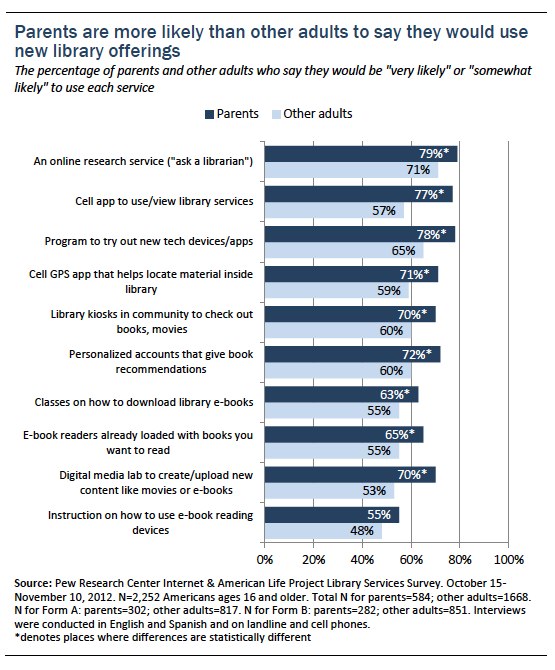 The vast majority of parents with children younger than 18 feel libraries are very important for their kids, leading to higher-than-average use of a wide range of library services, a new national report from the Pew Research Center shows. According to “Parents, Children, Libraries, and Reading,” 94 percent of parents feel libraries are important for their kids, with 79 percent describing libraries as “very important.” This is especially true of parents of young children (those under 6), some 84 percent of whom describe libraries as “very important.”
The vast majority of parents with children younger than 18 feel libraries are very important for their kids, leading to higher-than-average use of a wide range of library services, a new national report from the Pew Research Center shows. According to “Parents, Children, Libraries, and Reading,” 94 percent of parents feel libraries are important for their kids, with 79 percent describing libraries as “very important.” This is especially true of parents of young children (those under 6), some 84 percent of whom describe libraries as “very important.”
Of these parents, 84 percent say a major reason they want their children to have access to libraries is that libraries help inculcate their children’s love of reading and books, while 81 percent say libraries provide their children with information and resources not available at home, and 71 percent say libraries are a safe place for children. Almost every parent (97 percent of those surveyed) says it is important for libraries to offer programs and classes for children and teens.
“From the minute we started talking to library patrons in this research, it was apparent that parents are a special cohort because of their affection for libraries, their deep sense that libraries matter to their children, and their own use of libraries,” says Lee Rainie, director of the Pew Internet Project. “They do more and they are eager for more library services of every kind—ranging from traditional stuff like books in stacks and comfortable reading spaces to high-tech kiosks and more e-books and mobile apps that would allow them to access library materials while they are on the go.”
The report also found that the ties between parents and libraries start with the importance parents attach to the role of reading in their children’s lives. Half of parents of children under age 12 read to their child every day and another 26 percent do so a few times a week, while 58 percent of parents with children under age 6 read daily with them and 26 percent read multiple times a week with their children.
Other highlights of the report:
- 70 percent of parents say their child visited a public library in the past 12 months and 55 percent say their child has his/her own library card.
- Children who are library visitors use the library to borrow books, do school work, borrow DVDs and CDs, attend events, socialize with friends, or to attend a library-sponsored book club or program.
- Parents themselves are considerably more likely than other adults to use library services, and 30 percent of parents say their patronage of libraries has increased in the past five years.
- Compared with other adults who do not have children under 18, parents are more likely to have visited a library in the past 12 months, have a library card, to have visited a library website in the past year, and use a mobile device to connect to a library website.
- Parents are more likely to be interested in expanding library services and adding tech services.
- 43 percent of children ages 12 to 17 go to the library to use the internet.
 “Parents’ ties to libraries are all the more striking because parents are more likely than other adults to have computers, internet access, smartphones, and tablet computers,” notes Kathryn Zickuhr, research analyst at the Pew Internet Project. “The presence of this technology in their lives might make them less reliant on libraries because they have access to information and media through other convenient platforms. But the opposite is the case—the more technology they have, the more they’re likely to take advantage of library services.
“Parents’ ties to libraries are all the more striking because parents are more likely than other adults to have computers, internet access, smartphones, and tablet computers,” notes Kathryn Zickuhr, research analyst at the Pew Internet Project. “The presence of this technology in their lives might make them less reliant on libraries because they have access to information and media through other convenient platforms. But the opposite is the case—the more technology they have, the more they’re likely to take advantage of library services.
“The study also found that lower income parents (those in households earning less than $50,000) are more likely to view library services as very important. Compared to higher income parents, lower income parents say they would be “very likely” to take advantage of such technology and resources as classes on how to download library e-books (44 percent vs. 29 percent); e-readers already loaded with library content (40 percent vs. 22 percent); a digital media lab (40 percent vs. 28 percent); and classes on how to use e-readers (34 percent vs. 16 percent).
This report is part of a broader effort by the nonprofit Pew Research Center’s Internet & American Life Project that is exploring the role libraries play in people’s lives and in their communities. The research is underwritten by the Bill & Melinda Gates Foundation.
The data are based on nationally representative phone surveys conducted between October 15 and November 10, 2012, of 2,252 Americans ages 16 and above. The surveys were administered half on landline phones and half on cellphones, and in both English and Spanish. Some additional findings come from several online and in-person surveys of a non-scientific sample of 2,067 librarians and library staff members who volunteered to participate in the study.



Too bad kids dont love Libraries specially now with the internet everybody has access to it.